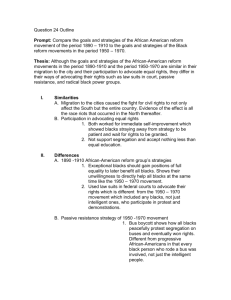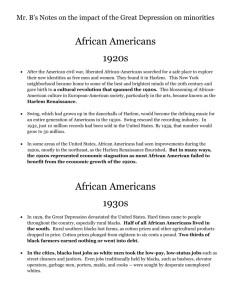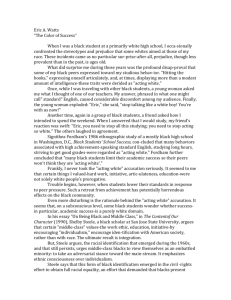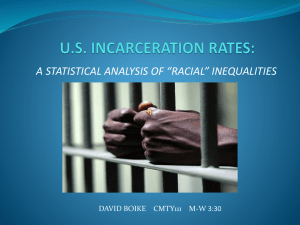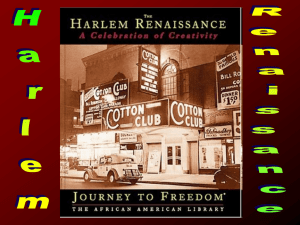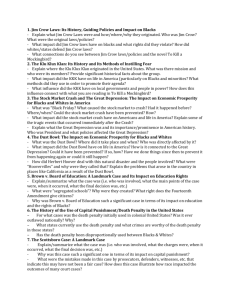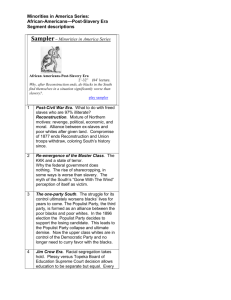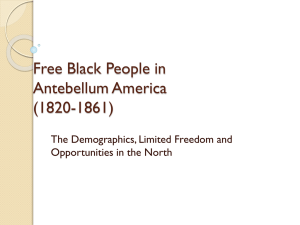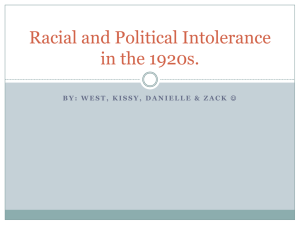Great Depression impact on Women and Minorities
advertisement
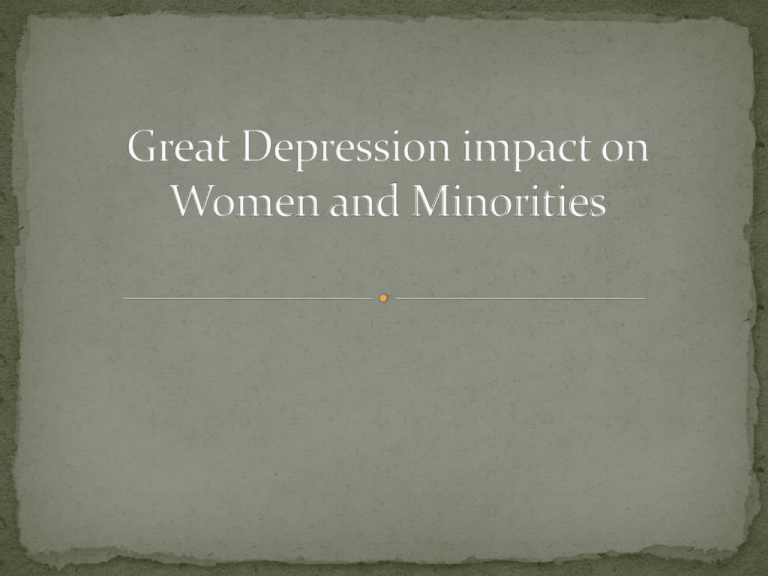
What are some issues Minorities may have faced that others did not have to deal with during the G D? Life improved in 1920’s North East Harlem renaissance- literature, education, and pride NY 1920’s Southern Blacks economic stagnation ½ of all blacks lived in the South Compromised many low wage high labor jobs Lost farms as cotton prices and other crops dropped Blacks would be fired from low pay jobs to open the job for white men Black women would lose domestic servant jobs to white women 1932 General Pop 25% unemployment African American 75% 40% of Black workers lost their jobs How could the government solve this inequality? Did benefit from Federal aid programs Public Works Administration &Works Progress Administrations A stipulation in these programs was to hire minorities Blacks made ¼ of residents in Fed Housing Project FDR forced nondiscrimination in hiring of Fed jobs Black Cabinet- Group of African American leaders under Roosevelt. Advised President on race issues and getting New Deal support to Blacks Pushed by Eleanor Roosevelt William Hastie and Mary McLeod Bethune Key members of the cabinet AAA- Denied support to tenant farms because they did not own land Federal programs at the local level would deny relief for blacks Racist managers at the local level made this choice and would not be caught Intimidations and lynching increased during the Great Dep What was the goal of the Black Cabinet? NAACP pushed Federal Law outlawing lynching but did not pass White southern Democrats did not allow it to pass South was unsafe for many blacks What would you do if you were a Black Southerner during the Great Depression? Worsening social and economic inequality in the South forced ½ million to move to northern cites to find work. factories and business began closing down and unemployment continued. Over all Blacks suffered More during the Great Depression NAACP supported striking white union workers IN Return White Unions began allowing blacks in 500,000 blacks joined labor unions There was about 2 million Latinos in the US most in the South West Most Latinos worked low wage labor jobs in agriculture or industry Families would follow the crops working in various areas yearly Jobs went to migrant whites Many relocated to cities Creating ethnic neighborhoods “Barrios New Deal Program Managers denied giving Latinos benefits and jobs claiming they were not citizens Many were citizens and still were denied rights Some areas Mexican Americans were denied access to school or service at hospitals Seen as unwanted immigrants and competition for jobs(despite many being citizens) What is a similarity and a difference between the struggles of Blacks and Latinos during the Great Dep. With influx of Latinos entering cities in search of jobs like LA Local governments to clear cities out of new migrants via forced Deportations Raids would gather up Mexican Americans and deport to Mexico Thousands of those deported were American Born US citizens Intimidations and deportations caused 500,000 to voluntarily return to Mexico. Nearly half of all Latinos were forced to relocate during the Great Dep Increased responsibility- fend for themselves and family when men went out to find work The View was jobs should go to men women should remain at home take care of family Women made up only 25% of the work force Men, unions, and government were not ready to accept working women, and this bias caused females intense hardship during the Great Depression. How have opinions changed in today's society Poorest- need to keep food n the table for family Middle Class- women worked to maintain level of life. Standard of living went up in the 1920’s families had to work harder to keep that standard Consumerism and material comforts of the 1920’s Working wives also expected to maintain the household Working Married women increase by 50% 1930’s Women were pushed out traditional jobs like teaching and into clerical , retail jobs, and domestic work Many educated women took positions well below their training What group of women would have the hardest time finding jobs? Those who could not find jobs created their own small business- Need to keep family financially in tact Black women lost jobs as cooks, maids, nurses, and laundresses Created small business with Boarding houses and Beauty parlors Since so many Blacks migrated north Women opened homes to migrants White owned salons did not cater to blacks open up beauty shops in homes These business helped generate income for families and needed little investment Eleanor Roosevelt championed women's rights 1st Female cabinet member –Secretary of Labor Frances Perkins New Deal programs also hired many women Problem -New Deal policies targeted at Men and primary bread winners Many jobs were labor intensive Women were hired in clerical needs in various New Deal Agencies


